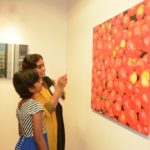SIGHT & INSIGHT by K Keerthi and P Uday Bhaskar Rao
On 11th April 2016
The two talented participating artists in the present show, Keerthi Kankipati and Uday Bhaskar Pendem make successful efforts in creating optically convincing illusions of reality simulating and assimilating what they have seen and experienced. Both artists painstakingly reconstruct narratives, capturing them through extreme photographic reality. This mode essentially necessitates the artists to use their adroit skills and precise focus on re-presenting the simulated reality or the improvised illusion, enhancing the visual sight and the appropriated/desired imagery. The paintings exhibited here create a sense of tangible solidity and substantial presence of substances that are familiar to us. Their clever use of volume, tactile quality and subtlety of chiaroscuro all manifest ensuring a complex understanding of real and natural.
As a popular genre, ‘Photorealism’ made its way into the mainstream in the late 60’s reacting to the high modernist tendencies and minimalist emotive intuitions in Western Art. It threw a challenge to mediumistic advocacy by delivering an alternative and innovative means for revolutionary insights into conventional drawing, painting and modernist montages particularly photo-graphic media. This curious visual feast allows the viewer to engage both aesthetically and critically. Due to its possible variants within the realm of illusion the genre is at times labeled, if not rigidly categorized, as Super-Realism, New-Realism, Mediatic-Realism and Hyper-Realism. However, the aspect of ‘intermedial’ simulation and the virtuosity with a certain kind of technical and semi-technical exploitations that are central to the incessant fruition of the both painting and sculpture challenge these arbitrary labels.
The magnificent set of paintings exhibited here fall in the lines of above said genre that is predominant in Post-Modern Art in India. Both artists explored the artistic trends during their post graduation in the College of Fine Arts and learnt the newer ideologies disseminated by their mentors. These recent paintings demonstrate their artistic insight as the use of imagery appears to be apolitical in nature but the very selection of it intends to create a dialogue about the status quo of artistic practice in the region. They are neither decorative nor ethnographic in character, but certainly resonate their personal experiences in the bubbling urbanity. Their approach to painting is very simple and modest but the study of rich tonalities is much more complex and reveal the true character of the objects they paint. The visual vocabulary for their naturalistic renditions is derived from ‘real’ via high-definition photographs and is sincerely replicated to show how real the unreal images are. For them anything and everything is an art piece in itself, it is only at the viewer’s behest that the objects unravel and explore the un-known dynamics that these ordinary things hold. As is evident, the hyper-realistic treatment of the banal objects creates a sense of deception, where the accurate tactile quality mesmerizes the viewer. The minute tonal differences become a means to create a sort of illusionistic/harmonious blend of real and unreal. Both artists effortlessly grasp the play of light and the changeability of the hues under different light sources.
Keerthi Kankipati also makes an effort to recapture ‘genuine’ emotions through her desired photographic images, framing and reframing them with thick layers of opaque hues. Her inclination for ‘photo-realism’ is visible as her naturalistic renditions express a sublime feeling as if they are tangible and conspicuous for the viewers to interact. A kind of disinterestedness in exercising with profligacy of ornamental imagery is what characterizes Keerthi’s approach as she engages herself in reducing abundance of metaphors, testing her own temperament and dealing with what she observes or rather perceives from her own perspective. The schema endowed by ‘photo-realism’ enables her to methodically demonstrate a choice of a clever ‘symbolism’ unambiguously and interest in precision unequivocally. The untainted paintings show her apprehension to the tainted environments caused by growing urbanization in the city. She cleverly translates her emotive expressions through incongruent ‘binaries’ and ‘contradictions’ in the context of shifting modes of life in his ever-changing city. Her deep concern about natural-nature and aberrant conditions of urban planning are evident in her astutely rendered paintings. Apparently, the dichotomy comes out in some of her artworks as she depicts lively lotus ponds on one hand, while at the other, cows at leisure but marooned on an arid landscape, embody the absence of lush greens that are encroached by the real Estates.
Uday Pendem’s long journey as an artist began learning traditional art particularly temple sculpture but it was during his training in the college of Fine Arts he honed both his hand skills and mind skills responding to the academic necessities. As acrylic paintings were replaced with fluidity of oil on canvases, rudimentary sketches took shape of wonderful compositions and adjusted to the newer trends in art. Be it a one-rupee coin, bunch of seasonal fruits or fresh vegetables, all turn into his artistic disquiet when he reframes them as aesthetic allegories. The reflection series, devoid of human presence, largely inspired by Richard Estes (the pioneer of the International Photo-Realist Movement of the late 1960s), is a critique of growing urban landscape in Hyderabad. In contrast to the nostalgic idea of his indigenous ambience, these paintings reflect his aversion to and disassociation with the sappy urbanization. The recent paintings show much more maturity and dexterity, as the artist precisely deals with the schema and the selection of imagery, which articulate both irony and reality whilst they are displayed in an Art Gallery.








